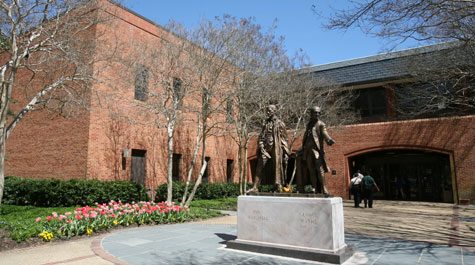The recent university admissions scandal regarding bribery for selective university placements has renewed conversations over the college admissions process at the College of William and Mary. Some of these conversations pertain to the policy of affirmative action, and its role in the college admissions process in the modern era. In a lecture April 15, associate professor of sociology Deenesh Sohoni examined the history and role of affirmative action and delved into discussing the policy’s benefits and consequences.
Sohoni’s talk, which was hosted by the College’s Asian Pacific American Law Association, focused on Asian Americans’ place in affirmative action. Ariana Cheng J.D. ’20 helped organize the event. Cheng shared the motivations behind having the talk, in light of the recent lawsuit against Harvard University.
“We’ve been discussing having a talk about affirmative action the entire year … discussing [the] Asian American population and [its] divisiveness when it comes to affirmative action, and being muted as not a minority,” Cheng said. “That’s why we wanted to have the talk and view it from a legal framework as well.”
In this lecture, Sohoni expressed that he believed affirmative action was still beneficial to Asian Americans, specifically those who still remain in underprivileged positions, and described how many individuals overlook other factors that influence admissions such as legacy, athletics and residency. Sohoni sought to explain the difficulty of establishing an exclusively merit-based system in admission to social institutions such as universities, and that noted that affirmative action continues to be an important factor in college admissions.
Sohoni began his talk by looking into the original purpose of affirmative action, investigated why it was installed and attempted to answer if its original intention was still valid. He provided historical context as well, referencing the policy’s creation as a desire to alleviate past discrimination of minority groups.
“These are specifically race-conscious types of policies, and it seems to benefit underrepresented groups, and was originally seen as a counter to the effect of past discrimination and continuing structural discrimination,” Sohoni said. “The original framework of affirmative action focused on trying to correct historical disadvantages of groups, and this is where we’re going to see a shift in how affirmative action has come to be understood in higher education.”
After originally being developed by President John Kennedy, affirmative action was strengthened by President Lyndon B. Johnson. While Johnson increased the legitimacy of affirmative action in political spheres, it was still devoid of a clear operational framework. However, Sohoni explained that affirmative action was among the first policies that specifically designated what a minority was, and how it also acted as a preemptive measure against discrimination.
Affirmative action has clearly evolved since the era of the civil rights movement, but Sohoni noted that it eventually began to evolve into a broader term that expanded beyond just racial dimensions. Sohoni spoke on how universities and other social institutions began to include all forms of diversity as important components of their bodies.
“We have a shift now from the idea of affirmative action serving to help previously disadvantaged groups, to being a compelling interest in higher education that diversity is a positive force,” Sohoni said. “This also changes things to see discussions about other forms of diversity. … Different universities have moved away from conceptualizing this as an issue strictly about race to other forms of diversity.”
Sohoni then spoke on the historical evolution of discrimination in the college admissions process, where affirmative action had gradually shifted towards becoming something to improve diversity, rather than just making up for generations of wrongdoings.
“When we started looking at the broad history, we’ve seen a shift from affirmative action as redeeming past discrimination as well as contemporary structural discrimination, to a new arsenate that universities have to use which is achieving diversity. … Diversity has become the compelling interest,” Sohoni said.
Sohoni explained that it is a widely generalized social stereotype that all Asian Americans are extremely accomplished individuals. However, he argued that there are many Asian American groups, including Mongolians and Cambodians, who still benefit from these policies.
“One kind of view of Asian Americans is that they are the model minority; it also encompasses this monolithic view of Asian Americans, but Asian Americans are a diverse population,” Sohoni said. “In essence if we’re looking at the whole review, Asian Americans should be supportive because not all Asian American are doing incredibly well in American society. … Affirmative action policies can help some of the groups that have not been as successful in the United States.”
Sohoni closed his lecture by discussing the different factors that influence college admissions, such as legacy, in-state residence and athletics, and questioned why these aspects receive less public ire than affirmative action. He continued by illustrating how difficult it would be to create a wholly merit-based system in admissions.
David Lim, a second-year student at the law school, thought Sohoni’s talk sparked an interesting dialogue concerning college admissions. Lim spoke on how other factors of admissions seemed to be overshadowed by the tension built around affirmative action.
“I think the most important point to take away from this presentation was that there are other preference systems in place for college admission,” Lim said. “He mentioned sports, he mentioned legacy, these are all things I think people over look on the debate of affirmative action.”
After the talk, Cheng shared what she believed was the biggest take way from the event. She described how she wanted to highlight the negatives and positives of affirmative action and look into how it will evolve.
“I think it’s good to be critical about how we can improve affirmative action policies,” Cheng said. “But we have to distinguish that from getting rid of affirmative action completely.”

